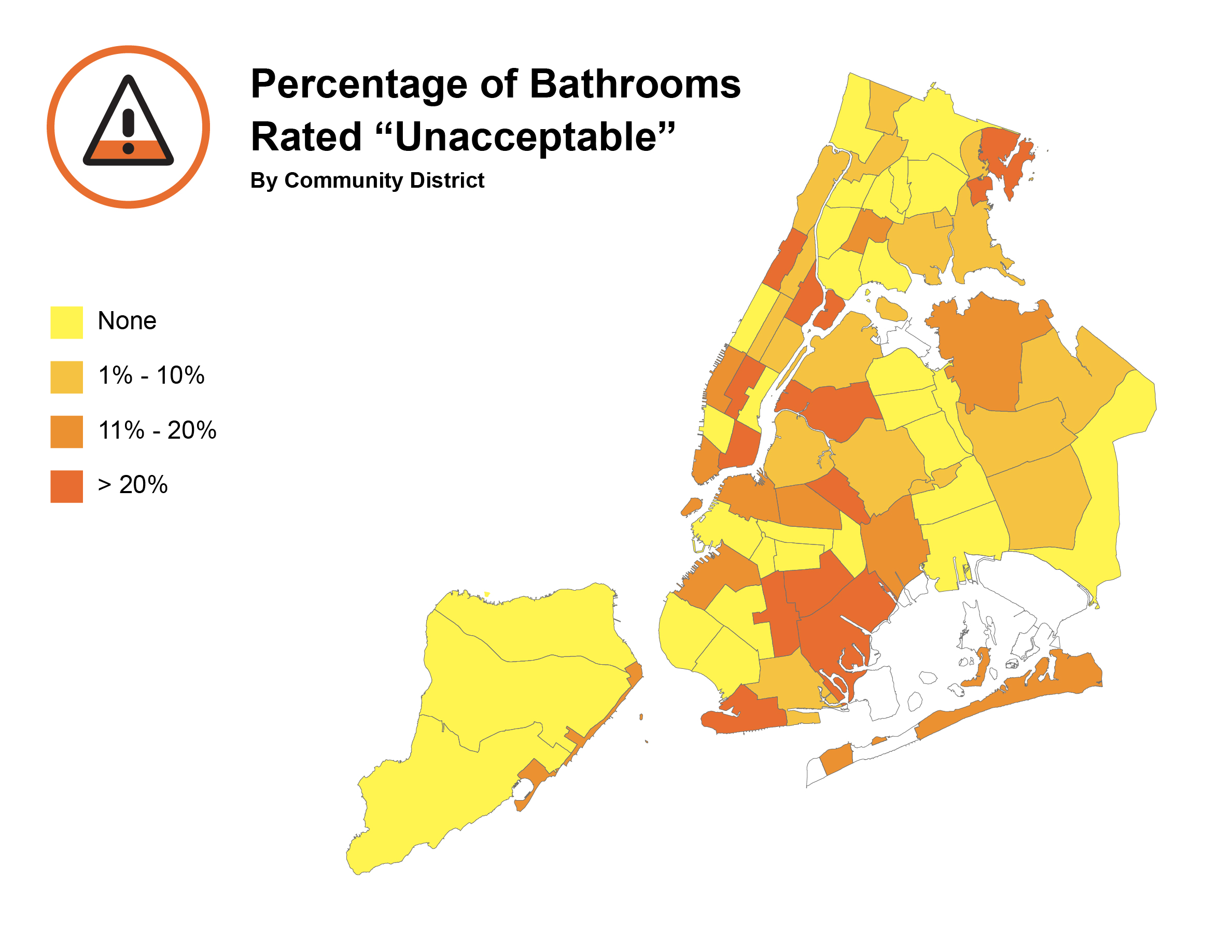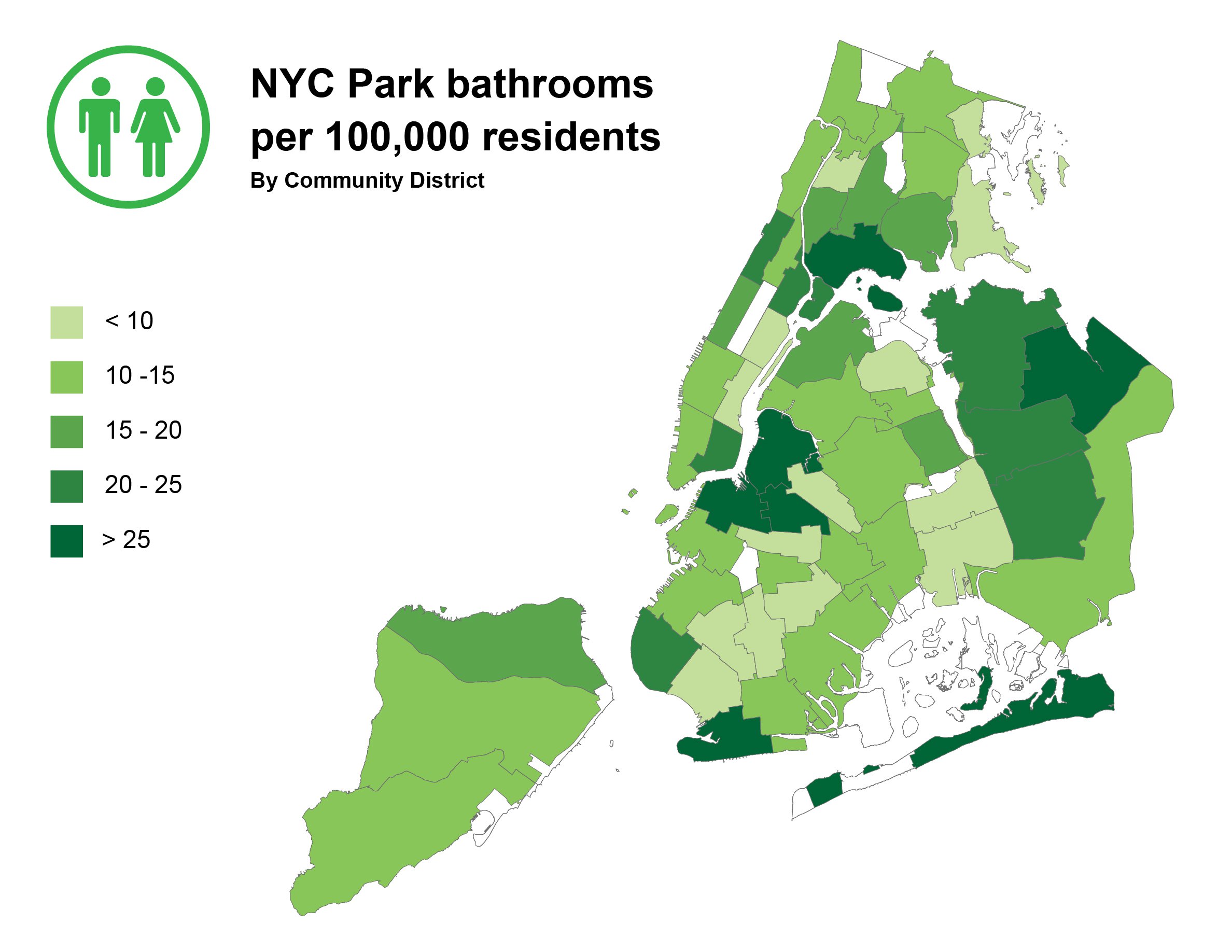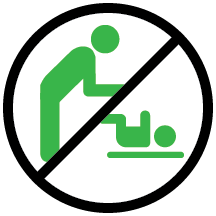Introduction
In the 1930s, as New York City embarked on a massive buildout of its park system, one feature was central to these efforts: the comfort station. Mayor Fiorello La Guardia and Commissioner Robert Moses understood that public bathrooms allowed New Yorkers to comfortably and confidently “move beyond their homes and fully participate in the life of the city,” helping to build a healthier, more active, and more sociable city.[1]
Whether changing a diaper, washing up, drying off, or everything in between, the comfort station continues to play this integral, if unsung, role in sustaining our parks and our public sphere. Moreover, as other agencies—notably the MTA—have opted to shutter existing facilities and shirk their basic responsibilities, NYC Parks remains committed to opening and operating these essential public facilities.
And yet, despite these noteworthy efforts, many NYC Parks comfort stations have fallen into disrepair, subject to poor maintenance and hazardous conditions. Among the 1,428 NYC Parks bathrooms, nearly 400 sinks, toilets, walls, ceilings, changing tables, and other features were damaged or missing during their latest inspection. Over 50 “hazards” were identified that presented the chance of moderate to debilitating injury. And, in nine Community Districts, more than a quarter of NYC Parks bathrooms were deemed “unacceptable.”
Chart 1: Number of comfort stations per 100,000 residents in the 100 largest U.S. cities
| Rank | City | Comfort Stations per 100,000 Residents |
| 1 | St. Paul | 210 |
| 2 | Jacksonville | 140 |
| 3 | Minneapolis | 137 |
| 4 | Chesapeake | 126 |
| 5 | Cincinnati | 125 |
| 6 | Milwaukee | 113 |
| 7 | Anchorage | 111 |
| 8 | Henderson | 102 |
| 9 | Anaheim | 100 |
| 10 | Louisville | 97 |
| 11 | St. Petersburg | 96 |
| 12 | Lincoln | 92 |
| 13 | Pittsburgh | 86 |
| 14 | Orlando | 85 |
| 15 | Buffalo | 84 |
| 93 | New York | 16 |
Source: The Trust for Public Land, “City Park Facts,” 2018.
Moreover, as the city has grown, the construction of new comfort stations has been slow to follow. Across our parks and playgrounds, there are just 16 bathrooms for every 100,000 residents. This ranks New York an embarrassing 93rd among the country’s 100 largest cities. By comparison, St. Paul, Jacksonville, Minneapolis, and Cincinnati each have more than 125 public bathrooms for every 100,000 residents (see Chart 1).
These deficiencies are even more acute in select neighborhoods across the five boroughs. In 10 community districts, for instance, there are fewer than eight NYC Parks comfort stations per 100,000 residents, including Bensonhurst, Flatbush & Midwood, Howard Beach & Ozone Park, Richmond Hill & Woodhaven, Borough Park, Jackson Heights & North Corona, and Crown Heights North & Prospect Heights.
Equally troubling, many of these bathrooms provide meager access to residents of the city. A paltry 31 percent of comfort stations in the five boroughs are ADA accessible, 11 percent are not open year-round, and 73 percent do not have changing stations for infants and toddlers.
Clearly, there are significant maintenance and construction deficiencies for NYC Parks to address. If the City hopes to improve the quality-of-life in its neighborhoods and open up its parks, playgrounds, and public spaces to children, seniors, and New Yorkers of all ages, then it must prioritize the essential, unheralded workhorse of the public sphere: the bathroom.
NYC Parks Bathrooms in Disrepair
Over the last three decades, NYC Parks has dramatically improved the maintenance of its core facilities. Whether comfort stations, playgrounds, or ball fields, the Department has made key investments in inspecting and repairing its assets and creating a more hospitable environment for local residents.[2]
And yet, despite this notable progress, far too many NYC Parks bathrooms remain in unseemly condition; repelling children, families, seniors, and everyday New Yorkers, rather than providing relief. In total, 100 bathrooms across the City were found to be in “unacceptable” condition during their most recent inspection. This included 15 percent of NYC Parks bathrooms in Manhattan and 12 percent in Brooklyn (see Chart 2).
Chart 2: Percentage of NYC Parks bathrooms in “unacceptable” condition
Source: NYC OpenData. “Parks Inspection Program – Comfort Station Room Inspections.” May 2, 2019.
Conditions are even more problematic when drilling down to the neighborhood level. In nine Community Districts, more than a quarter of NYC Parks bathrooms were rated “unacceptable” due to a) multiple features being unsatisfactory, b) one feature having a serious safety hazard, or c) the bathroom having a failed cleanliness rating.[3]
Chart 3: Community Districts with the most bathrooms rated “unacceptable”
| Neighborhoods | Community District | Number of NYC Parks Bathrooms | Share Rated Unacceptable |
| Chinatown & Lower East Side | Manhattan CD 3 | 36 | 40% |
| East Harlem | Manhattan CD 11 | 30 | 39% |
| Flatbush & Midwood | Brooklyn CD 14 | 8 | 33% |
| East Flatbush, Farragut & Rugby | Brooklyn CD 17 | 12 | 33% |
| Hamilton Heights, Manhattanville & West Harlem | Manhattan CD 9 | 30 | 27% |
| Canarsie & Flatlands | Brooklyn CD 18 | 32 | 26% |
| Midtown Business District | Manhattan CD 5 | 6 | 25% |
| Bushwick | Brooklyn CD 4 | 14 | 25% |
| Sunnyside & Woodside | Queens CD 2 | 14 | 25% |
Source: NYC OpenData. “Parks Inspection Program – Comfort Station Room Inspections.” May 2, 2019.
Topping the list was Chinatown and the Lower East Side, where 40 percent of park bathrooms were found to be unacceptable (see Chart 3), followed by East Harlem (39 percent) and Flatbush and Midwood (33 percent).
Chart 4: Percentage of bathrooms rated “unacceptable,” by Community District

Source: NYC OpenData. “Parks Inspection Program – Comfort Station Room Inspections.” May 2, 2019.
Looking more closely at these facilities, inspectors identified 53 “hazards” within NYC Parks bathrooms that presented the chance for moderate to debilitating injury. These included exposed wires, damaged or missing safety straps on changing stations, noxious odors, and inadequate lighting. In total, hazardous features were found in 38 unique bathrooms, including 17 in Brooklyn, eight in Manhattan, seven in the Bronx, five in Queens, and one in Staten Island (see Chart 5).
Chart 5: Number of bathrooms with hazardous conditions, by borough
Source: NYC OpenData. “Parks Inspection Program – Comfort Station Conditions & Hazards.” May 2, 2019.
Of course, dangerous and injury-threatening conditions are not the only problems that New Yorkers must contend with. NYC Parks inspectors also found 399 bathroom components that were in non-hazardous, but unacceptable condition. This included 29 toilets, urinals, sinks, and hand dryers that were out-of-service, 23 soap dispensers missing or damaged, 23 ceilings, walls, and floors deteriorated, and 17 damaged changing tables. Of the 207 NYC Parks bathrooms with at least one feature in unacceptable condition, 57 were in Brooklyn, 57 were in Queens, 49 were in Manhattan, 37 were in the Bronx, and seven were in Staten Island.
Underserved: Geographic disparities in NYC Parks bathrooms
While New Yorkers in some neighborhoods and boroughs are subject to unclean, unsavory, and unsafe bathrooms, many others have far too few facilities, severely limiting the time they can spend in their local parks and playgrounds.
Looking across the five boroughs, the number of NYC Parks bathrooms varies considerably, from 4 for every 100,000 residents in Morris Heights (Bronx Community District 11) to 33 per 100,000 residents in Brighton Beach & Coney Island (Brooklyn Community District 13).
Chart 6: NYC Parks bathrooms per 100,000 residents, by Community District

Source: NYC OpenData. “Parks Inspection Program – Comfort Station Room Inspections.” May 2, 2019.
In 10 Community Districts, there are fewer than eight NYC Parks bathrooms per 100,000 residents, including Bensonhurst, Flatbush & Midwood, Howard Beach & Ozone Park, Richmond Hill & Woodhaven, Borough Park, Jackson Heights & North Corona, and Crown Heights North & Prospect Heights. Among the ten most underserved Community Districts, four are located in Brooklyn and three are in Queens (see Chart 7).
Chart 7: Community Districts with the fewest NYC Parks bathrooms per 100,000 residents
| Neighborhood | Community District | Number of NYC Parks Bathrooms | Population | Bathrooms per 100,000 residents |
| Morris Heights, Fordham South & Mount Hope | Bronx CD 5 | 6 | 148,274 | 4.0 |
| Bensonhurst & Bath Beach | Brooklyn CD 11 | 10 | 206,099 | 4.9 |
| Flatbush & Midwood | Brooklyn CD 14 | 8 | 150,596 | 5.3 |
| Howard Beach & Ozone Park | Queens CD 10 | 8 | 139,318 | 5.7 |
| Richmond Hill & Woodhaven | Queens CD 9 | 10 | 152,504 | 6.6 |
| Murray Hill, Gramercy & Stuyvesant Town | Manhattan CD 6 | 10 | 150,209 | 6.7 |
| Borough Park, Kensington & Ocean Parkway | Brooklyn CD 12 | 10 | 146,580 | 6.8 |
| Jackson Heights & North Corona | Queens CD 3 | 12 | 170,242 | 7.0 |
| Crown Heights North & Prospect Heights | Brooklyn CD 8 | 10 | 141,733 | 7.1 |
| Upper East Side | Manhattan CD 8 | 16 | 214,293 | 7.5 |
Source: NYC OpenData. “Parks Inspection Program – Comfort Station Room Inspections.” May 2, 2019.
For many New Yorkers, however, the presence of an NYC Parks bathroom does not ensure access. Among the agency’s 1,400 comfort stations city-wide, over 900 do not have a single ADA accessible bathroom.[4] This includes 73 percent of comfort stations in Queens, 70 percent in Brooklyn and Manhattan, and 67 percent in the Bronx where bathroom stalls are too small, urinals are mounted too high, sinks are out of reach, entryways are too narrow, and other accessible features are absent (see Chart 8).
Chart 8: Percentage of NYC Parks bathrooms that are not ADA Accessible, by borough
Source: NYC Parks. “Parks Bathrooms Locations.”
Meanwhile, at 75 parks and playgrounds throughout the five boroughs, bathrooms are not properly winterized and only open seasonally. On nice days in the early spring or late fall, these comfort stations will remain closed and their surrounding parks will be left significantly less hospitable for children, seniors, and everyday New Yorkers. In total, comfort stations in 15 percent of Brooklyn, 14 percent of Queens, and 13 percent of Staten Island parks and playgrounds are not open year-round (see Chart 9).[5]
Chart 9: Percentage of NYC Parks bathrooms that are only opened seasonally, by borough
Source: NYC Parks. “Parks Bathrooms Locations.”
And finally, only 27 percent of NYC Parks bathrooms are outfitted with changing stations. This low figure is particularly disconcerting given the history of comfort station construction in the five boroughs. Providing space for parents to change diapers and tend to their babies was, in fact, an important impetus for building out NYC Parks bathrooms in the first place. Parks Commissioner Robert Moses was concerned that parents would “have to trudge home from Central Park every time their baby’s diaper need[ed] changing,” cutting short their “uninterrupted time outdoors.” But while “Moses imagined diaper-changing stations dotting New York’s parks,” over 1,000 NYC Parks bathrooms are currently without one (see Chart 10).[6]
Chart 10: Number of NYC Parks bathrooms without a changing station, by borough
Source: NYC OpenData. “Parks Inspection Program – Comfort Station Room Inspections.” May 2, 2019.
Recommendations
NYC Parks should increase investment in maintenance and operations
While NYC Parks has made important strides to improve the safety and cleanliness of its facilities in recent years, there are still far too many bathrooms in disrepair. Moving forward, the City should increase their budget for maintenance and operations, particularly in those neighborhoods where bathrooms have far too many “hazardous conditions.”
NYC Parks should install changing stations in all of its public bathrooms
Across the five boroughs, more than 1,000 NYC Parks bathrooms lack changing stations for infants and toddlers. This is unacceptable. At a time when the City is mandating that all new and substantially renovated shopping malls, movie theaters, and museums install changing tables, it must also consider its own responsibilities to local families and young children. To this end, NYC Parks should outfit all 1,428 of its public bathrooms with safe and compliant changing stations over the next two years.
NYC Parks should develop a comprehensive plan to dramatically upgrade existing bathrooms and build out new ones
As much as the bench, the ballfield, or the slide, the comfort station is essential to thriving parks and public spaces. Without them, children, seniors, and everyday residents are severely restricted from spending time outdoors and engaging with their community. Unfortunately, these restrictions are quite high in New York City, which ranks 93rd in comfort stations per capita among the 100 largest American cities.
To address these deficiencies, NYC Parks comfort stations must be weatherized, made accessible, and significantly expanded. These efforts should be directed by a comprehensive plan and coupled with procurement reform to standardize the design and costs of new comfort stations.
Acknowledgements
Comptroller Scott M. Stringer thanks Adam Forman, Chief Policy & Data Officer and the lead author of this report. He also recognizes the important contributions made by David Saltonstall, Assistant Comptroller for Policy; Angela Chen, Senior Web Developer and Graphic Designer; Eugene Resnick, Senior Press Officer; Tian Weinberg, Senior Press Officer; Alex Wunrow, Digital Media Manager; Tyrone Stevens, Director of Communications; and Susan Watts, Director of Visual Content.
Endnotes
[1] Burgess, Rebekah and Mariana Mogilevich. “Cataloging Comfort,” Urban Omnibus. May 02, 2018.
[2] Surico, John. “A New Leaf: Revitalizing New York City’s Aging Parks Infrastructure,” June 2018. Center for an Urban Future.
[3] NYC Parks. “Mayor’s Management Report: Indicator Definitions.”
[4] NYC Parks. “Parks Bathrooms Locations.” https://www.nycgovparks.org/facilities/bathrooms.
[5] Ibid.
[6] Cohen, Rhaina. “How Wall-Mounted Changing Tables Enabled Moms to Leave the House,” The Atlantic. January 7, 2017.



